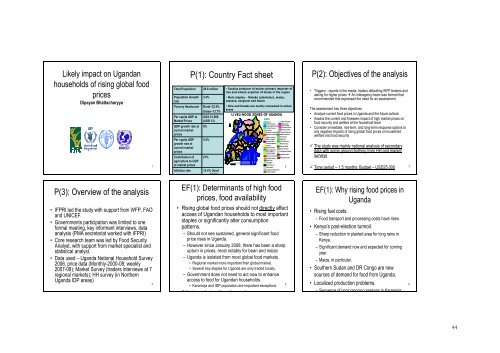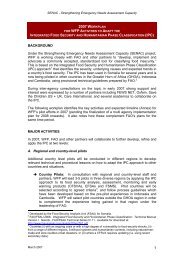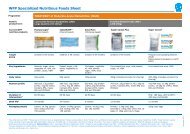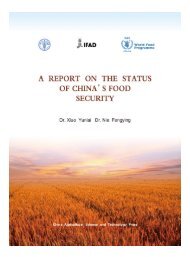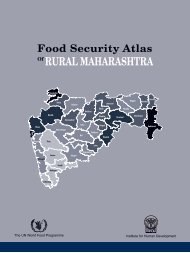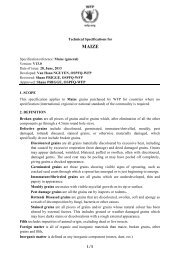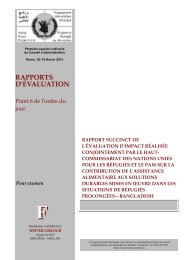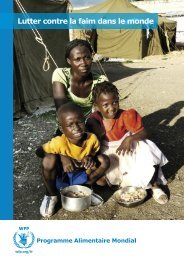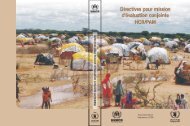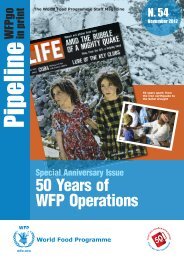High Food Price Impact Assessment and Analysis - WFP Remote ...
High Food Price Impact Assessment and Analysis - WFP Remote ...
High Food Price Impact Assessment and Analysis - WFP Remote ...
Create successful ePaper yourself
Turn your PDF publications into a flip-book with our unique Google optimized e-Paper software.
Likely impact on Ug<strong>and</strong>an<br />
households of rising global food<br />
prices<br />
Dipayan Bhattacharyya<br />
1<br />
Total Population<br />
Population Growth<br />
rate<br />
Poverty Headcount<br />
P(1): Country Fact sheet<br />
3.4%<br />
Per capita GDP at<br />
Market <strong>Price</strong>s<br />
GDP growth rate at 9%<br />
current market<br />
prices<br />
Per capita GDP 5.5%<br />
growth rate at<br />
current market<br />
prices<br />
Contribution of 21%<br />
agriculture to GDP<br />
at market prices<br />
Inflation rate<br />
29.6 million<br />
Rural–32.4%<br />
Urban–13.7%<br />
UGX 21,000<br />
(USD 13)<br />
12.4% (food<br />
15 4%)<br />
• Surplus producer of maize; primary importer of<br />
rice <strong>and</strong> wheat; exporter of maize in the region<br />
• Main staples – Matoke (plantains), maize,<br />
cassava, sorghum <strong>and</strong> beans<br />
• Rice <strong>and</strong> breads are mainly consumed in urban<br />
areas<br />
LIVELIHOOD ZONES OF UGANDA<br />
N<br />
0 50 Kilometers<br />
LEGEND<br />
Fishing<br />
Maize-Pineapple<br />
Fishing-Tourism Maize-Gnuts<br />
Fishing-Salt Extraction Tea-Livestock<br />
Tea-Annual Crops<br />
Fishing Cassava<br />
Livestock<br />
Tobacco-Coffee<br />
Sorghum-Livestock Tobacco-Sugarcane<br />
Cassava-Livestock Tobacco-Cassava<br />
Maize-Livestock Horticultural<br />
Millet-Livestock Sugarcane<br />
Livestock-Rice Crop Production<br />
Livestock-Banana Mixed Farming<br />
Pastoral<br />
Arabica-Coffee<br />
Banana-Coffee<br />
Cotton-Simsim<br />
Banana-Annuals<br />
Banana-Maize The <strong>High</strong>l<strong>and</strong> Plateau<br />
Cassava-Coffee<br />
Protected Areas<br />
Cassava-Livestock-Cereal<br />
Pulses-Cassava Urban/Peri-urban<br />
Root Crop<br />
Rice-Millet<br />
Rice-Tobacco<br />
Rice-cotton<br />
2<br />
Sorghum-Pigeon peas<br />
Potato-sorghum<br />
P(2): Objectives of the analysis<br />
• Triggers - reports in the media, traders defaulting <strong>WFP</strong> tenders <strong>and</strong><br />
asking for higher prices An interagency team was formed that<br />
recommended that expressed the need for an assessment.<br />
The assessment has three objectives<br />
• Analyze current food prices in Ug<strong>and</strong>a <strong>and</strong> the future outlook<br />
• Assess the current <strong>and</strong> foreseen impact of high market prices on<br />
food security <strong>and</strong> welfare at the household level<br />
• Consider immediate, mid-term, <strong>and</strong> long-term response options to<br />
any negative impacts of rising global food prices on household<br />
welfare <strong>and</strong> food security<br />
The study was mainly national analysis of secondary<br />
data with some ground-truthing from HH <strong>and</strong> market<br />
surveys<br />
Time period – 1.5 months; Budget – USD25,000<br />
3<br />
P(3): Overview of the analysis<br />
• IFPRI led the study with support from <strong>WFP</strong>, FAO<br />
<strong>and</strong> UNICEF.<br />
• Governments participation was limited to one<br />
formal meeting, key informant interviews, data<br />
analysis (PMA secretariat worked with IFPRI)<br />
• Core research team was led by <strong>Food</strong> Security<br />
Analyst, with support from market specialist <strong>and</strong><br />
statistical analyst.<br />
• Data used – Ug<strong>and</strong>a National Household Survey<br />
2006, price data (Monthly-2000-08; weekly<br />
2007-08); Market Survey (traders interviews at 7<br />
regional markets); HH survey (in Northern<br />
Ug<strong>and</strong>a IDP areas)<br />
4<br />
EF(1): Determinants of high food<br />
prices, food availability<br />
• Rising global food prices should not directly affect<br />
access of Ug<strong>and</strong>an households to most important<br />
staples or significantly alter consumption<br />
patterns.<br />
– Should not see sustained, general significant food<br />
price rises in Ug<strong>and</strong>a.<br />
– However since January 2008, there has been a sharp<br />
upturn in prices, most notably for bean <strong>and</strong> maize<br />
– Ug<strong>and</strong>a is isolated from most global food markets.<br />
• Regional market more important than global market.<br />
• Several key staples for Ug<strong>and</strong>a are only traded locally.<br />
– Government does not need to act now to enhance<br />
access to food for Ug<strong>and</strong>an households.<br />
5<br />
• Karamoja <strong>and</strong> IDP population are important exceptions.<br />
• Adopt an alert wait <strong>and</strong> see stance<br />
EF(1): Why rising food prices in<br />
Ug<strong>and</strong>a<br />
• Rising fuel costs.<br />
– <strong>Food</strong> transport <strong>and</strong> processing costs have risen.<br />
• Kenya’s post-election turmoil.<br />
– Sharp reduction in planted area for long rains in<br />
Kenya.<br />
– Significant dem<strong>and</strong> now <strong>and</strong> expected for coming<br />
year.<br />
– Maize, in particular.<br />
• Southern Sudan <strong>and</strong> DR Congo are new<br />
sources of dem<strong>and</strong> for food from Ug<strong>and</strong>a.<br />
• Localized production problems.<br />
– Sequence of poor cropping seasons in Karamoja;<br />
6<br />
44


